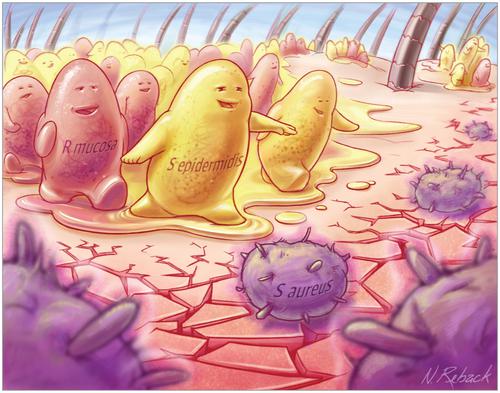JAMA ( IF 63.1 ) Pub Date : 2018-09-18 , DOI: 10.1001/jama.2018.12334 Jennifer Abbasi

|
A few years ago, LCDR Ian A. Myles, MD, got a hunch about eczema, an itchy, infection-prone inflammatory skin disease that affects 13% of children and 7% of adults in the United States. Looking at research articles, Myles, who is a chief medical officer of the US Public Health Service Commissioned Corps and an immunologist at the National Institute of Allergy and Infectious Diseases (NIAID), noticed an overlap in regions of the body colonized by gram-negative bacteria—the elbow folds, the backs of the knees, around the neck, and on the hands—and those frequently affected by eczema. This got him and a colleague thinking: Could these types of bacteria, which weren’t generally associated with skin conditions, have something to do with this one?
They suspected that gram-negative bugs were actually protective. People with healthy skin have more of the microbes on their bodies than people with eczema. Some categories of gram-negative bacteria, like those found on the skin, are known to produce beneficial lipids that are deficient in patients with eczema. And the fact that children usually outgrow eczema could be explained by acquiring healthy bacterial strains in day care, preschool, and beyond.
Eczema, also known as atopic dermatitis, has been linked since the 1970s with changes in the skin microbiome. In particular, people with the condition tend to have more gram-positive bugs—the other category of bacteria—on their skin than those without eczema. Up to 90% of people with eczema have gram-positive Staphylococcus aureus on their skin, which can worsen flare-ups and cause serious staph infections. But the interplay of eczema and gram-negative bacteria hasn’t been as well understood.
中文翻译:

细菌移植是湿疹治疗的未来吗?
一个几年前,LCDR伊恩·迈尔斯A.,MD,得到了一个关于湿疹,瘙痒,感染易发炎症性皮肤疾病,影响儿童的13%,在美国成年人的7%的预感。迈尔斯(Myles)是美国公共卫生服务管理委员会的首席医疗官,也是美国过敏和传染病研究所(NIAID)的一名免疫学家,他观察研究论文时发现,革兰氏阴性菌所定植的身体部位存在重叠。细菌-肘部褶皱,膝盖后部,脖子周围以及手部-以及经常受湿疹影响的细菌。这使他和一位同事想到:这些与皮肤状况通常不相关的细菌可能与这种细菌有关吗?
他们怀疑革兰氏阴性菌实际上是保护性的。皮肤健康的人比湿疹的人体内的微生物更多。已知某些种类的革兰氏阴性细菌,例如在皮肤上发现的那些,会产生有益的脂质,而这些脂质在湿疹患者中是缺乏的。儿童通常会长出湿疹这一事实可以通过在日托,学龄前及以后获得健康的细菌菌株来解释。
自1970年代以来,湿疹(也称为特应性皮炎)与皮肤微生物组的变化有关。特别是,与没有湿疹的人相比,患有这种病的人的皮肤上往往有更多的革兰氏阳性菌(另一类细菌)。多达90%的湿疹患者皮肤上具有革兰氏阳性金黄色葡萄球菌,这可能会使爆发加剧,并引起严重的葡萄球菌感染。但是,人们对湿疹和革兰氏阴性菌之间的相互作用尚不甚了解。











































 京公网安备 11010802027423号
京公网安备 11010802027423号